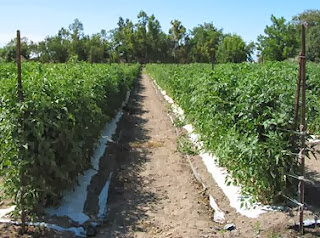Information on growing tomatoes for beginners - Growing tomatoes information collected randomly from magazines or Internet can often seem contradictory or confusing. There are really only three main factors to consider for growing super delicious tomatoes, sweet and juicy at home.
First Factor - Soil
Tomatoes constantly need rich, moist soil nutrients for proper growth. The ground begins to depend on whether you are growing your tomatoes from seeds or seedlings.
If you are a purist who prefers to start from the beginning, then you will start tomato seeds recently acquired or stored properly. When from seed, you should use a mixture of starting seeds, which can be easily obtained from your local garden center. After the seeds have germinated, they can be transplanted into pots ordinary soil.
If you are like most tomato growers at home, you will start your tomatoes from seedlings obtained from your local garden center - the fastest and easiest route. If that's the case, then you can start with ordinary potting soil for. Just make sure you properly fortify your soil for growth two months to go.
The easiest and least expensive way to ensure soil health is to simply add compost or fertilizer bags for potting soil. Special fertilizer is not necessary and may even be harmful.
Tomato plants require at least 6-8 hours of good sunlight each day for proper growth. Over 6 to 8 hours of sunlight would be better.
If tomatoes have been transplanted to your ultimate outdoor environment, make sure the area is free enough shade. Many beginners just assume outdoors is outdoors and adequate sunlight is automatic. Not so. Too much shade during the day to prevent the growth of your tomato plants.
If you are growing your tomatoes in containers indoors, keep plants near windows that receive at least 6-8 hours of exposure to sunlight. If no window is only that amount of sunlight, you may need to move plants to different windows during the day to add to the amount of light needed.
Third Factor - Water
This can be tricky. Very little water because plants wilt, while excess water can lead to problems such as blossom end rot. A good rule of thumb is to water every other day.
Avoid drowning your plants when you water. Tomato plants prefer a constant amount of water that is not overwhelming. In addition, your tomato plants not watered overhead like flowers. The water in the stem and leaves can expose plants to pests and diseases. Apply water to the soil around the roots. That's where needed.
Some growers prefer a way as drip irrigation technique. You can use a drip hose, or a cheap and simple approach, simply bury a gallon container of water in the soil near the roots. Poke a few small holes in the bottom and fill the container with water, allowing water to drip slowly out of the bottom on the floor over time.






No comments:
Post a Comment